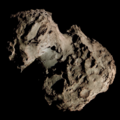450P/LONEOS
 Infrared image of 450P/LONEOS taken by the Spitzer Space Telescope on 4 March 2007 | |
| Discovery[1][2] | |
|---|---|
| Discovery site | LONEOS |
| Discovery date | 13 January 2004 |
| Designations | |
| P/2004 A1, P/2022 Q3 | |
| LONEOS 8 | |
| Orbital characteristics[3][4] | |
| Epoch | 5 May 2024 (JD 2460800.5) |
| Observation arc | 21.39 years |
| Earliest precovery date | 25 October 2003 |
| Number of observations | 629 |
| Aphelion | 10.442 AU |
| Perihelion | 5.449 AU |
| Semi-major axis | 7.945 AU |
| Eccentricity | 0.31423 |
| Orbital period | 22.396 years |
| Inclination | 10.653° |
| 124.35° | |
| Argument of periapsis | 23.148° |
| Mean anomaly | 332.08° |
| Last perihelion | 25 August 2004 |
| Next perihelion | 29 January 2027 |
| TJupiter | 2.961 |
| Earth MOID | 4.465 AU |
| Jupiter MOID | 0.184 AU |
| Physical characteristics[3][5] | |
Mean radius | 0.5–3.5 km (0.31–2.17 mi) |
| (V–R) = 0.51±0.21 | |
| Comet total magnitude (M1) | 6.7 |
| Comet nuclear magnitude (M2) | 11.3 |
450P/LONEOS, also known by its formal designations P/2004 A1 and P/2022 Q3, is a distant periodic comet with a 22-year orbit around the Sun.
Observational history
[edit]Discovery
[edit]The comet was discovered as an 18th-magnitude object on CCD images taken by Brian A. Skiff as part of the Lowell Observatory's LONEOS program.[1] The LONEOS images show the object with a stellar-like appearance, but its motion prompted Skiff to request additional observations. H. R. Miller (Perkins Observatory) and J. Young (Table Mountain Observatory) later found a coma about 4 arcseconds in diameter and a very faint tail about 10 arcseconds in length, confirming its cometary nature.[1] The first orbital calculations were later published on the Minor Planet Center's website on 13 January 2004, alongside precovery images taken by the Kitt Peak Observatory dating as far back as 18 December 2003.[2]
Follow-up observations
[edit]The comet was successfully recovered from observations taken by the Gemini North Observatory in August 2022, where it was noted to be 4.5 magnitudes fainter than previously predicted.[6][7]
Orbit
[edit]As of 2024[update], 450P/LONEOS has a heliocentric orbit inclined about 10.65 degrees from the ecliptic. Its perihelion distance is about 5.45 AU (815 million km) while its aphelion goes as far back as 10.44 AU (1.562 billion km) from the Sun.[4] Orbital calculations indicated that it made a close encounter with Saturn in 1992, when it came within 0.031 AU (4.6 million km) to the giant planet.[3] This resulted in its semimajor axis to be significantly decreased by 5.2 AU (780 million km).[8] A long-term orbital investigation indicated that this is likely its first sojourn to the inner Solar System as it transitions from a centaur into a Jupiter-family comet.[8][9]
Physical characteristics
[edit]Based on its measured dust activity, the nucleus of 450P/LONEOS is likely somewhere between 0.5 km (0.31 mi) to 3.5 km (2.2 mi) in radius.[5]
References
[edit]- ^ a b c B. A. Skiff; H. R. Miller; J. Young (13 January 2004). D. W. Green (ed.). "Comet P/2004 A1". IAU Circular. 8267. Bibcode:2004IAUC.8267....1S.
- ^ a b B. G. Marsden (13 January 2004). "MPEC 2004-A51: Comet P/2004 A1". www.minorplanetcenter.net. Minor Planet Center. Retrieved 11 May 2025.
- ^ a b c "450P/LONEOS – JPL Small-Body Database Lookup". ssd.jpl.nasa.gov. Jet Propulsion Laboratory. Retrieved 11 May 2025.
- ^ a b "450P/LONEOS Orbit". Minor Planet Center. Retrieved 11 May 2025.
- ^ a b E. M. Epifani; M. Dall’Ora; D. Perna; P. Palumbo; L. Colangeli (2011). "The Cometary Activity of Centaur P/2004 A1 (LONEOS)" (PDF). Monthly Notices of the Royal Astronomical Society. 415 (4): 3097–3106. Bibcode:2011MNRAS.415.3097M. doi:10.1111/j.1365-2966.2011.18919.x.
- ^ D. W. Green (8 October 2022). "Comet P/2004 A1 = P/2022 Q3 (LONEOS)". Central Bureau for Astronomical Telegrams. 5178.
- ^ "MPEC 2022-T106: Comet P/2004 A1 = P/2022 Q3 (LONEOS)". www.minorplanetcenter.net. Minor Planet Center. 8 October 2022. Retrieved 11 May 2025.
- ^ a b E. Lilly; P. Jevcak; C. A. Schambeau; K. Volk; J. Steckloff; et al. (2024). "Semimajor-axis Jumps as the Activity Trigger in Centaurs and High-perihelion Jupiter-family Comets". The Astrophysical Journal. 960 (2): L8. arXiv:2312.06847. Bibcode:2024ApJ...960L...8L. doi:10.3847/2041-8213/ad1606.
- ^ G. Hahn; C. I. Lagerkvist; O. Karlsson; T. Oja; R. M. Stoss (2006). "P/2004 A1 (LONEOS) – A Comet under Transition from Saturn to Jupiter". Astronomische Nachrichten. 327 (1): 17–20. Bibcode:2006AN....327...17H. doi:10.1002/asna.200510484.
External links
[edit]- 450P/LONEOS at the JPL Small-Body Database
- 450P/LONEOS at Seiichi Yoshida's website


